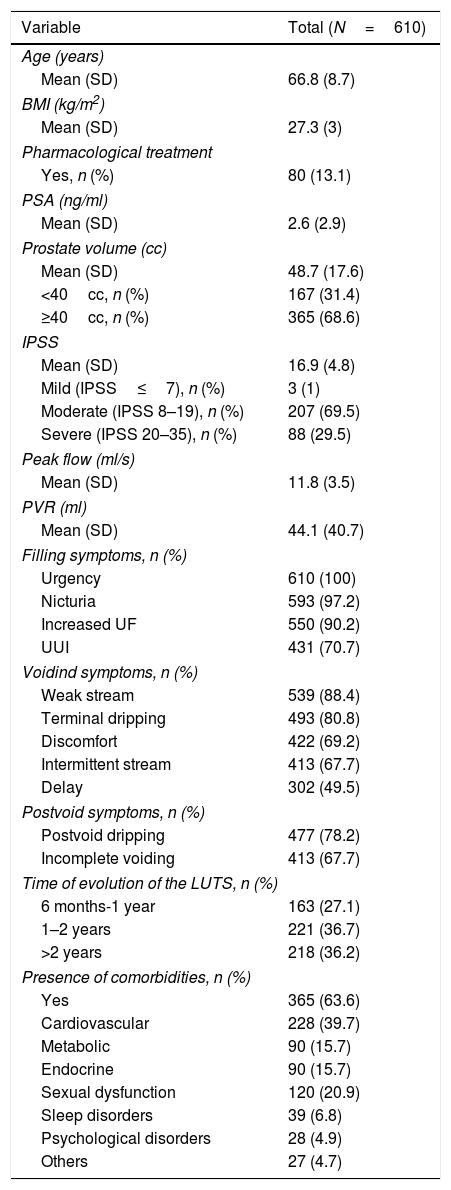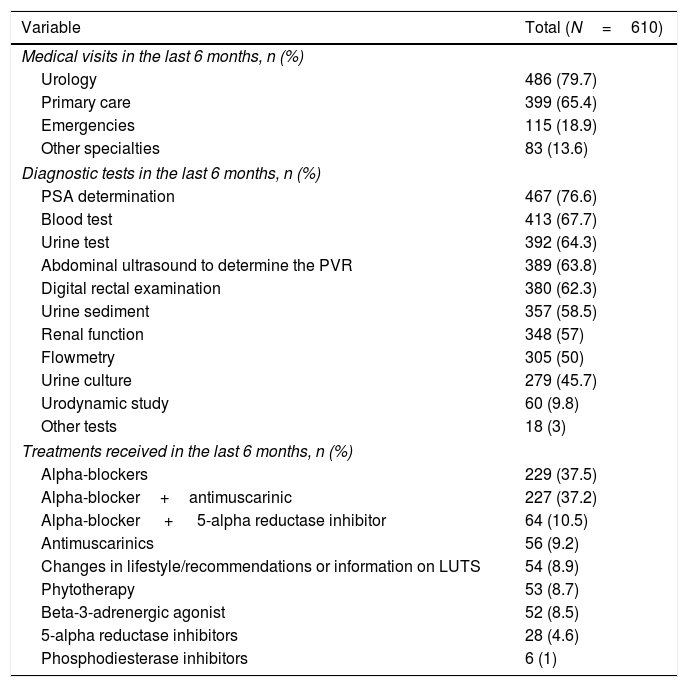To explore the management of lower urinary tract symptoms (LUTS) in men in Spain and assess the compliance with recommendations established in the European Association of Urology (EAU) guidelines.
Material and methodsMERCURY was an epidemiological and cross-sectional study which involved 227 Urology Units across Spain assessing adult male patients with mixed LUTS and persisting storage symptoms. Sociodemographic, clinical and resource use data for the 6 months prior to study inclusion were collected. Additionally, through a theoretical clinical case, clinicians described their attitude toward the diagnostic and therapeutic management of males with mixed LUTS and persisting storage symptoms during the first and second visits. Answer options given to clinicians about LUTS management were aligned with those recommended by EAU guidelines.
Result610 patients included in the study were evaluated. 87.7% of them consumed some health resource mainly due to: urologist visits (79.7%), PSA determination (76.6%) and treatment with alpha-blockers (37.5%) and alpha-blockers plus antimuscarinics (37.2%). According to the theoretical clinical case, urologists preference toward diagnostic tools and pharmacological treatment in first visit were mainly PSA determination (97.7%), digital rectal examination (91.4%) and treatment with alphablockers as monotherapy (56.6%), whereas in the second visit uroflowmetry (48.9%), voiding diary (40.3%) and treatment with alpha-blockers plus antimuscarinics (70.6%) were mainly preferred.
ConclusionsUrologists attitude toward management of male patients with mixed LUTS and persisting storage symptoms is aligned with that recommended in the EAU guidelines.
Conocer el manejo de pacientes varones con síntomas del tracto urinario inferior (STUI) y evaluar el seguimiento de las recomendaciones de las guías de la Asociación Europea de Urología en España.
Material y métodosEl estudio MERCURY, epidemiológico y transversal, con 227 unidades de urología participantes en España, evaluó a pacientes varones con STUI mixtos predominantemente de llenado, de los cuales se recogió información sociodemográfica, clínica y de consumo de recursos de los 6 meses anteriores. Adicionalmente, mediante un caso clínico teórico, los investigadores describieron su actitud sobre el manejo de los STUI mixtos con predominio de llenado persistentes tras un tratamiento inicial, en cuanto a pruebas diagnósticas y aproximación terapéutica en la primera y la segunda visita. Las opciones proporcionadas para el manejo de los STUI estaban alineadas con las recomendaciones de la Asociación Europea de Urología.
ResultadosSe evaluaron 610 pacientes, de los cuales el 87,7% consumió algún recurso sanitario debido a: visitas al urólogo (79,7%), determinación del PSA (76,6%) y tratamiento con alfabloqueante (37,5%) y alfabloqueante más antimuscarínico (37,2%). En el caso clínico teórico, la actitud del urólogo en la elección de pruebas diagnósticas y tratamiento farmacológico fue principalmente: determinación del PSA (97,7%), tacto rectal (91,4%) y tratamiento con alfabloqueantes en monoterapia (56,6%) en la primera visita; flujometría (48,9%), diario miccional (40,3%) y tratamiento con alfabloqueante más antimuscarínico (70,6%) en la segunda visita.
ConclusionesLa actitud de los urólogos en España para el manejo del paciente varón con STUI mixtos predominantemente de llenado se ajusta a las recomendaciones de las guías clínicas europeas.











